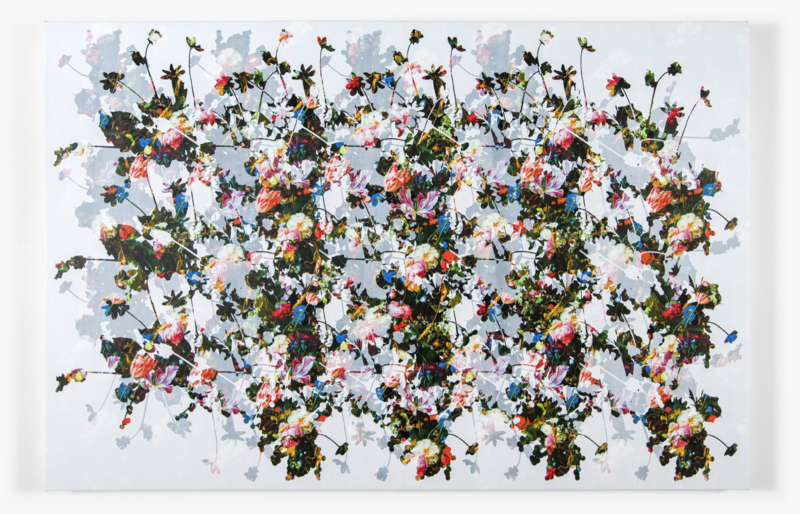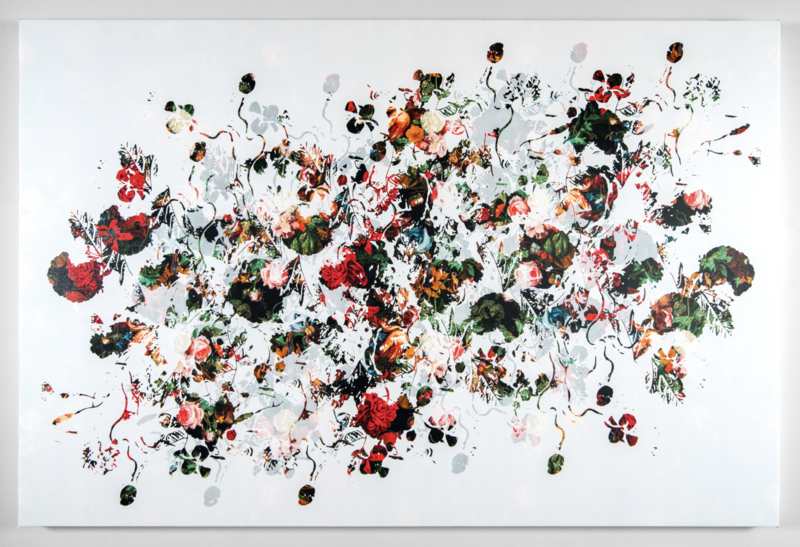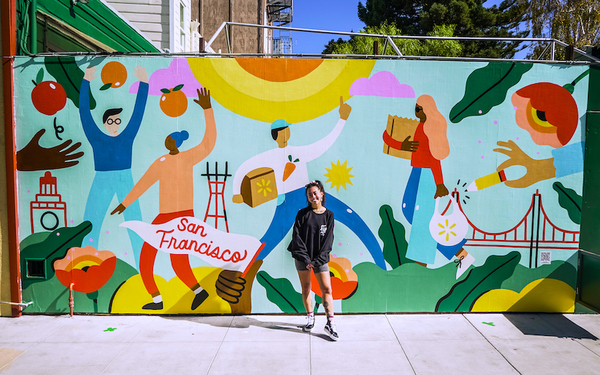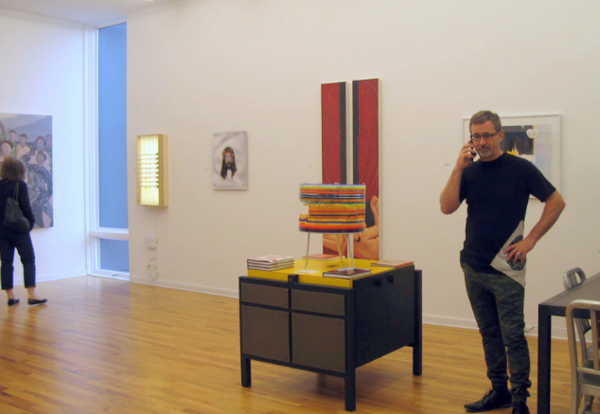“Flowers bud, bloom, wilt, & then others sprout up in their place.”
In her current work, Artwork Archive's Featured Artist J. Myszka Lewis blends the beauty of 17th-century Dutch still-life floral elements with the vibrant aesthetic and thoughtful concepts of the Pattern and Decoration movement. Through her paintings and works on paper, she explores themes of ornament, time, and impermanence.
J. Myszka Lewis chooses flowers as her subject because their short lives mirror our own mortality. "They bud, bloom, wilt, and then others sprout up in their place," she explains in her artist statement. The artist sees the natural lifespan of flowers as a metaphor for the routines, behaviors, and events that repeat throughout our lives.
Her work merges historical imagery of flowers, once symbols of a classist culture and sold at high prices, with the feminist values of the Pattern and Decoration movement, which challenged fine art hierarchies. These seemingly opposing themes come together in her work, depicting a contemporary culture filled with distractions and a fixation on beauty and aesthetics.
She hopes her meditative creative process translates into a similarly meditative experience for viewers, inviting them to lose themselves in the details, daydream, and reflect on their own values and expectations.
Artwork Archive had the chance to chat with J. Myszka Lewis about her creative process, insights she has for other artists, and how Artwork Archive helps her manage her art career.
You can see more of her work on Discovery and learn more about her art practice below:
 J. Myszka Lewis, When Faces Called Flowers Float Out of the Ground, 48 x 72 x 1.5 in, 2024
J. Myszka Lewis, When Faces Called Flowers Float Out of the Ground, 48 x 72 x 1.5 in, 2024
Can you walk us through your creative process? How do you begin a piece, and how do you know it's complete?
Over the last few years, I've been building a library of source material that I pull from when I start new work. Most of the images I save for this purpose are 17th-century Dutch flower paintings that I scan from textbooks or contemporary staged photographs of bouquets or individual cut flowers from reference books. I also look at wallpaper patterns from various eras for inspiration.
I've developed a collection of wallpaper-esque patterns that I create by editing, manipulating, and repeating imagery extracted from Dutch paintings.
I usually start a new piece by developing a pattern built from silhouetted forms and then matching it to one of my background patterns. As I pair the layers of patterns, I can see what areas need to be changed or adjusted and then work back and forth between the top layer and the background until I resolve the composition.
I aim to create areas where the imagery and forms in the multiple layers seem united and others where they contrast or oppose each other. I try to balance the overall impact of the work with small areas of detail that hold the viewer's attention and lead them throughout the piece.
I digitally sketch out and develop plans for each piece before I begin the physical production process, so there are many opportunities to adjust each element of the various patterns.
How do you choose specific floral images for your work, and what criteria do you use in selecting them?
I'm especially attracted to Dutch paintings that depict floral still lifes against a dark background or include insects or little critters.
The dark backgrounds establish a sense of placelessness and timelessness, which speaks to our recurring attraction to flowers. I also look for small details that could easily be overlooked; these are often the elements I have the most fun exaggerating in my pieces.
When selecting images to create the silhouetted patterns for the stenciled layers in my paintings or watercolor drawings, I look for contours and shapes that quickly shift between evoking botanical life and being more ambiguous.
The work isn't only about flowers, so I want to abstract the imagery in some areas to leave room for viewer interpretation and personal connection.

A view inside J. Myszka Lewis' art studio. Photo courtesy of the artist
In your artist statement, you mention the Dutch flower paintings that inform your work depict lavish bouquets as objects symbolic of prosperity and abundance. Can you elaborate on how you interpret this symbolism in the context of your own work?
Flowers are such timeless objects; we continue to relate to them even as years go by and our culture and society change.
We gift flowers to celebrate birthdays or anniversaries or to honor our deceased. They are beautiful and frivolous, offering small moments of reflection.
Much of the source imagery for my work comes from a time in history when flowers were sold at exorbitant prices and became symbols of a classist culture. My work also references the Pattern and Decoration movement, which emerged in the mid-1970s and championed decorative and craft-based aesthetics as equal to figuration, minimalism, and conceptualism in art.
While seemingly contradictory, these positions come together within my work to depict our contemporary culture, which is full of distractions and easily fixated on aesthetics and beauty. Although we don't view flowers in quite the same way today as in 17th-century Dutch culture, the concept and attraction of abundance persists, which is one concept I'm exploring.
In hindsight, what's something you wish you knew before becoming a professional artist?
I wish I better understood what it meant to operate as a small business as an artist.
It's not just the basics of writing artist statements and applying for opportunities, but also the importance of networking and building relationships with others in the industry.
I have found the most meaningful progress I've made results from years of consistent work, both in and outside of the studio. And, persistently stepping outside my comfort zone as I set goals and create a business plan that aims to meet those goals.
Guide to laying a foundation and building a successful art career:
From knowing if you are ready for a full-time art career, to choosing the right name, making a business plan, and nailing down the legal stuff, Artwork Archive's Guide to Starting an Art Business will help you lay a strong foundation for your successful art career.
What impact do you hope your artwork will have on those who view it?
My work is very methodical and meditative for me to create, so I hope it offers a similar meditative experience to the viewer.
It seems silly to say, but I want people to enjoy the experience of looking at my work!
I want people to use the opportunity to let their minds wander, get lost in the details, think about how they connect to the work, and overall reflect.
What's next for you? Are there any upcoming projects or exhibitions you're particularly excited about? How do they build on or divert from your current thematic focus?
After having back-to-back exhibitions and projects for over a year, I'm about to enter a bit of a slower season.
I have been enjoying the challenge of creating work for specific exhibitions, but I'm looking forward to slowing down and spending time on ideas I've been dreaming about but haven't had the time to work on.
I've made a lot of stenciled paintings so far this year, so I'm going to shift gears for a while and develop some watercolor pencil drawings that focus on repeated silhouetted botanical forms that begin to resemble lace.
I'll also be showing at my first art fair this July! I will have a booth at Art Fair on the Square, which is organized by the Madison Museum of Contemporary Art in Madison, Wisconsin. I have a few commissions coming up, too. Commissions typically require me to think about my work slightly differently, and those perspectives usually result in some growth in the studio, which is always great.
 J. Myszka Lewis, For We Are Only the Rind and the Leaf, 48 x 72 x 1.5 in, 2024
J. Myszka Lewis, For We Are Only the Rind and the Leaf, 48 x 72 x 1.5 in, 2024
Was there a specific instance or time you realized you needed something like Artwork Archive to inventory your artwork and manage your art career? Can you tell us about that instance and why you decided on Artwork Archive?
I love organization, so early in my art career, I started looking for a system to keep track of all my artwork details.
I tried a few basic database systems for a few years, and they worked well enough to store artwork information, but I transitioned to Artwork Archive when I started showing more often and making more sales.
My background is in printmaking, and I still occasionally make editions, so I was drawn to how Artwork Archive manages edition information.
I also love how I can store exhibition details, my contact lists, invoices, sales history, and everything else I might need in one system and have them all linked together.
How do you use Artwork Archive on a daily basis?
I often review Artwork Archive to remind myself which pieces I have available in my studio versus what is out at galleries while planning for applications, studio visits, and upcoming exhibitions.
I use the artwork notes section to record production notes I might want to reference later. I've also started adding more notes to my contact records to track when I've sent PDFs of artwork to clients, when I might need to follow up with a sales lead, and other important details.
What advice would you give an artist who's just starting out in their professional career?
First, trust your gut; make the art that you want to see in the world.
Then, surround yourself with people who are also motivated and passionate about their work. Community is powerful.
Find a mentor, ask questions, set goals, stay curious, but always anchor everything in the art.

J. Myszka Lewis, To Quiver and Hold, 36 x 84 x 1.5 in, 2024
J. Myszka Lewis uses Artwork Archive to organize her artwork, keep track of her editions, generate invoices, and a whole lot more.
You can make an online portfolio, catalog your artwork, and generate reports like inventory reports, tear sheets, and invoices in seconds with Artwork Archive. Take a look at Artwork Archive's free trial and start growing your art business.


.png)

2448.png)


79aa.png)
